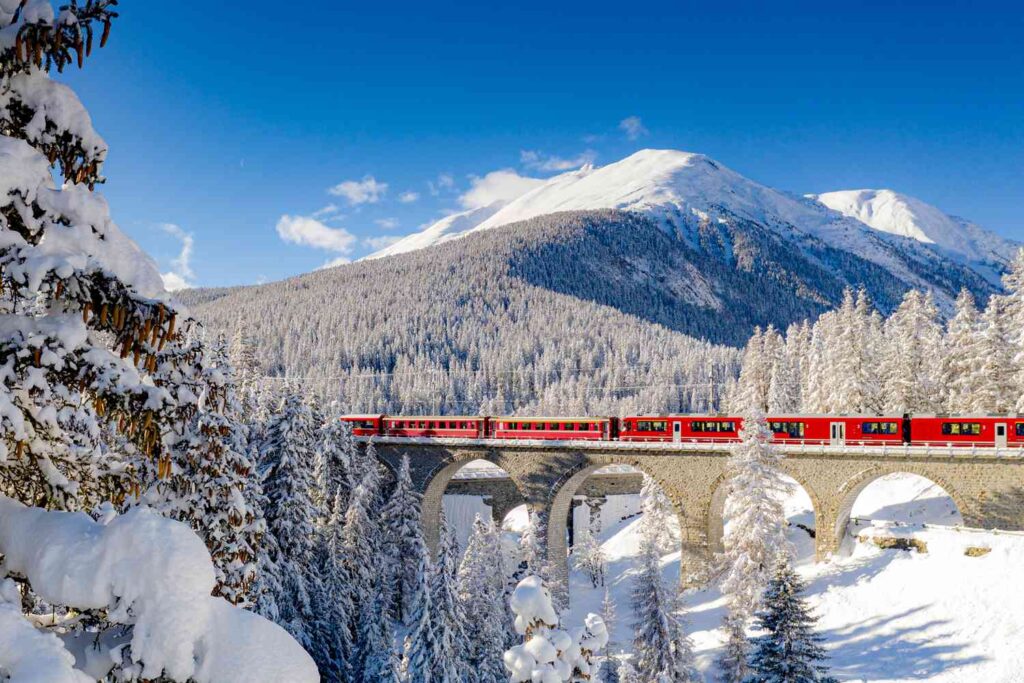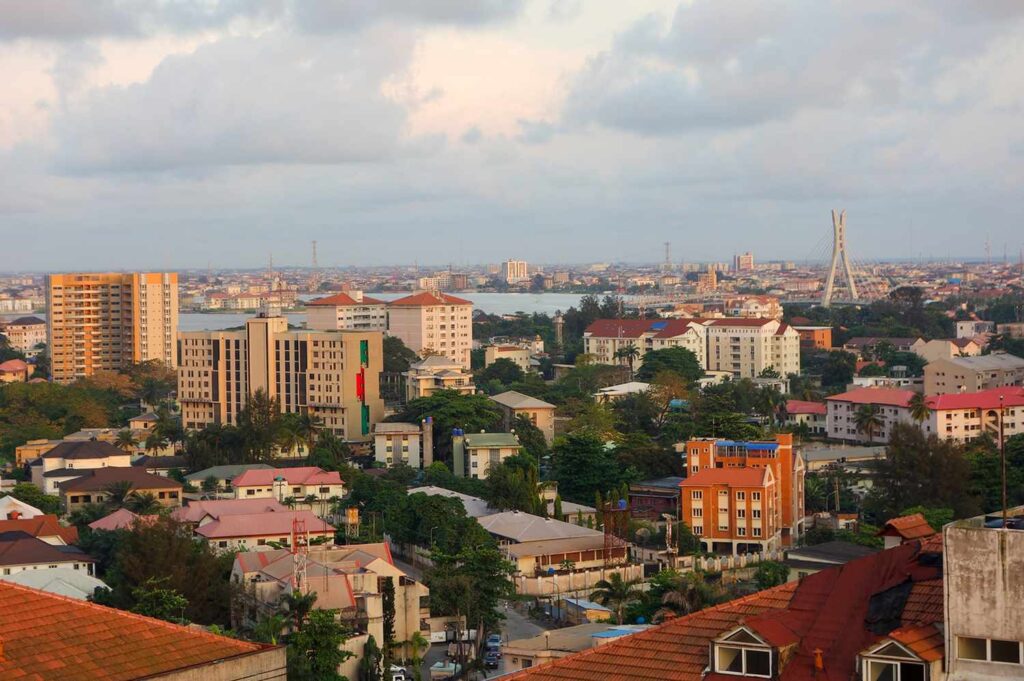:max_bytes(150000):strip_icc():format(jpeg)/TAL-lead-image-GLACIEREXPRESS1124-9e23d1f929d048deb1ff1074379fa7ee.jpg)
Switzerland is a country where natural beauty and efficient, comfortable train travel go hand in hand. Nowhere is this more apparent than on the Glacier Express, a traveler-favorite train that chugs along the 181 miles between Zermatt and St. Mortiz. It may be deemed the “slowest express train in the world,” but don’t let that deter you; the route gives way to some of the most jaw-dropping scenery, especially in the winter.
“In just eight hours, we glide from the majestic Matterhorn across the Swiss Alps to St. Moritz,” says Mika Geiger, a member of the Glacier Express team, “and the panoramic windows offer a clear view of snow-covered mountain peaks and breathtaking landscapes up to the ceiling.” In the colder months, a blanket of white adds an extra dose of coziness to the small villages, alpine valleys, and thick forests that pass by. It’s almost like riding through a snow globe, just on a grand scale.
Already dreaming of this picture-perfect train journey? Read on to discover everything you need to know about riding the Glacier Express.
Route and Schedule
Roberto Moiola / Sysaworld / Getty Images
The Glacier Express train runs both directions between Zermatt and St. Mortiz, two of the most well-known winter sports destinations in Switzerland. It operates mostly year-round, but service pauses from mid-October to the beginning of December. While the full eight-hour journey is the original (and most popular) route, passengers can also embark and disembark at Brig, Andermatt, Chur, Fillisur, and Samedan, depending on the train’s exact route. You can find the summer and winter timetables and train stops on the Glacier Express website.
According to Geiger, you should choose the route based on what scenery you’d like to see and how long you want to travel. If you want to experience something akin to the Polar Express, definitely book a winter trip. In good winters, she says, you can “admire the meter-high walls of snow around Zermatt and St. Moritz and on the Oberalp Pass, which is also the highest point of the journey,” she says. “When the sun shines breathtakingly beautifully, there is a fascinating contrast between the bright blue sky and the glistening white snow — a sight that warms my heart and brings the magic of winter to life.”
Tickets and Reservations
Lauren Breedlove/Travel + Leisure
There are a few ways you can book tickets, but the most straightforward way is to go through the Glacier Express website. Here, you can purchase your ticket — which will vary in price by trip length — and your seat reservation. Seat reservations are mandatory, and second- or first-class reservations can be booked up to 93 days in advance; an excellence-class reservation can be booked at any time. Fare can be purchased at a later date.
Second-class fare ranges from $42 to $180 (for the entire eight-hour journey). First-class fare starts at $71 and reaches $308 for the ride between Zermatt and St. Mortiz. Excellence-class fare is a flat rate of $308. Anyone with an active Swiss Travel Pass, Eurail Pass, Interrail Pass, or GA travel card — which covers the fare for the entire route — still has to make a seat reservation for an additional fee. Reservations for second or first class cost $55 for long journeys and $50 for short journeys (available only in the summer, or by request in the winter); excellence-class reservations start at around $555.
Geiger recommends booking your seat reservation well in advance. Seats tend to sell out during the most popular seasons, summer and winter.
Classes of Service
Courtesy of Glacier Express
There are three classes aboard the Glacier Express: second class, first class, and excellence class. Second and first class are quite similar in their offerings — pre-ordered meals, Wi-Fi, power outlets, and lowerable windows enhance the passenger experience — but the seating arrangements are slightly different. In second class, four seats face one other at each table; in first class, one side of the train has two seats facing one another while the other side has four.
Excellence class takes it up several more levels, starting at the welcome desk. Upon check-in passengers can choose to hand over their luggage, allowing for hands-free boarding. Perhaps the most glamorous aspect of the excellence-class cabin is its luxury leather seating, arranged with just two window seats facing one another at a table. As you get situated in the 20-person car, you’ll be welcomed with a glass of Champagne and an aperitif platter; a personal well-being concierge also ensures your entire journey is seamless. While second- and first-class passengers have a headset to use for the en-route audio guide, excellence-class passengers have tablets and headphones to follow along on the journey.
Another key difference from the two other service classes is the food and beverage spread. Those in excellence class enjoy a seasonal five-course menu (wine and non-alcoholic drinks included) and have exclusive access to the Glacier Bar for cocktails and more wine, should they so desire.
What to Expect on Board
TopPhotoImages/Getty Images
Eight hours may seem like a long time to ride a train, but this is the type of journey that flies by. Plus, the spacious seats are outfitted with armrests and head cushions, making sure you ride in comfort. The most obvious feature of the Glacier Express — and why it’s such an incredible experience — is its windows and skylights, allowing for panoramic views on the entire route. With this in mind, Geiger advises passengers to bring a camera and sunglasses.
Though you may be tempted to take photos the entire time, past passengers do note the glare and reflections can cause issues with the images. Geiger suggests using a polarizing filter or heading to the windows at the entry door, which can be lowered for better photos.
Food and drink are a highlight for many Glacier Express travelers, especially the ones hoping for their own Hogwarts Express-like experience. All of the meals are made on board and include regional and seasonal ingredients; the wine is also from the cantons of Valais and Graubünden. Along with the pre-ordered meal in second and first class, there are snacks and drinks available for purchase — but you’re free to bring your own food and drinks, too. Anyone in excellence class can enjoy complimentary drinks, snacks, and afternoon tea, along with their meal.
Points of Interest
Lauren Breedlove/Travel + Leisure
If you’ve booked a seat on the Glacier Express, you’re seeking out some of the best views in the world — and the journey isn’t going to disappoint. In the summer, you’ll see lush alpine meadows, wildflowers, and waterfalls. Come winter, the landscape dramatically shifts and snow covers everything: the mountains, the forests, and the charming Swiss towns. No matter when you choose to ride, there are several points of interest to keep a look out for.
In Zermatt, the Matterhorn towers nearly 15,000 feet in the air. The shrinking Rhône Glacier, the train’s namesake, is the source of the Rhône River and a popular photo op. At 6,670 feet above sea level, the Oberalp Pass is the highest point of the journey and home to an unexpected sight: a lighthouse. “The lighthouse is the exact copy, although smaller in scale, of a lighthouse which once stood in Rotterdam where the Rhine flows into the sea. So make sure to look out the window before reaching the station at Oberalp Pass to catch a glimpse,” says Geiger.
The Rhine Gorge, otherwise known as the “Grand Canyon of Switzerland,” is particularly stunning, and the train offers views of cliffs, vineyards (in the warmer months), and the river below. You may recognize the Landwasser Viaduct, an iconic railway bridge that curves into the Landwasser Tunnel; as you cross the viaduct, look out for the views of dense forests and impressive mountains. Other key places to see include the Solis Viaduct, the Engadine Valley, and the Engadine Lakes.


